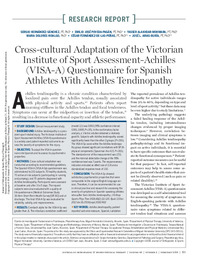Please use this identifier to cite or link to this item:
https://hdl.handle.net/11000/34582Full metadata record
| DC Field | Value | Language |
|---|---|---|
| dc.contributor.author | Sánchez-Hernández, Sergio | - |
| dc.contributor.author | POVEDA-PAGÁN, EMILIO J. | - |
| dc.contributor.author | ALAKHDAR-MOHMARA, YASSER | - |
| dc.contributor.author | HIDALGO, MARIA DOLORES | - |
| dc.contributor.author | Fernández-de-las-Peñas, César | - |
| dc.contributor.author | ARIAS-BURÍA, JOSÉ L. | - |
| dc.contributor.other | Departamentos de la UMH::Patología y Cirugía | es_ES |
| dc.date.accessioned | 2025-01-16T17:33:22Z | - |
| dc.date.available | 2025-01-16T17:33:22Z | - |
| dc.date.created | 2018-02 | - |
| dc.identifier.citation | J Orthop Sports Phys Ther. 2018 Feb;48(2):111-120 | es_ES |
| dc.identifier.issn | 1938-1344 | - |
| dc.identifier.issn | 0190-6011 | - |
| dc.identifier.uri | https://hdl.handle.net/11000/34582 | - |
| dc.description.abstract | Study Design Clinical measurement study. Background Achilles tendinopathy is a prevalent sport-related injury. The Victorian Institute of Sport Assessment-Achilles (VISA-A) questionnaire is a widely used patient-reported outcome to assess the severity of symptoms for this injury. Objective To adapt the VISA-A questionnaire into Spanish and to assess its psychometric properties. Methods Cross-cultural adaptation was conducted according to recommended guidelines. The Spanish VISA-A (VISA-A-Sp) questionnaire was administered to 210 subjects: 70 healthy students, 70 active at-risk subjects (participating in running and jumping), and 70 patients diagnosed with Achilles tendinopathy. Participants were assessed at baseline and after 3 to 5 days. The injured subjects were also evaluated with a quality-of-life questionnaire (Medical Outcomes Study 36-Item Short-Form Health Survey [SF-36]) and at discharge. The final VISA-A-Sp was evaluated for reliability, validity, and responsiveness. Results Cronbach alpha for the VISA-A-Sp was greater than .8. The intraclass correlation coefficient (model 2,1) was 0.993 (95% confidence interval: 0.991, 0.995; P<.05). In the confirmatory factor analysis, a 1-factor solution obtained a relatively good fit. Subjects with Achilles tendinopathy scored significantly lower than the other 2 groups (P<.001). The VISA-A-Sp score within the Achilles tendinopathy group showed significant correlations with SF-36 physical components (Spearman rho>0.5, P<.001). The standard error of the measurement was 2.53, and the minimal detectable change at the 95% confidence level was 7 points. The responsiveness indicators included an effect size of 2.16 and a standardized response mean of 1.92. Conclusion The VISA-A-Sp showed satisfactory psychometric properties that were comparable to the original English-language version. Therefore, it can be recommended for use in clinical practice and research for assessing the severity of symptoms in Spanish-speaking athletes who suffer from Achilles tendinopathy | es_ES |
| dc.format | application/pdf | es_ES |
| dc.format.extent | 12 | es_ES |
| dc.language.iso | eng | es_ES |
| dc.publisher | Williams And Wilkins | es_ES |
| dc.rights | info:eu-repo/semantics/openAccess | es_ES |
| dc.rights | Attribution-NonCommercial-NoDerivatives 4.0 Internacional | * |
| dc.rights.uri | http://creativecommons.org/licenses/by-nc-nd/4.0/ | * |
| dc.subject | Achilles tendinopathy | es_ES |
| dc.subject | patientreported outcome measure | es_ES |
| dc.subject | Spanish | es_ES |
| dc.subject | validation | es_ES |
| dc.title | Cross-cultural Adaptation of the Victorian Institute of Sport Assessment-Achilles (VISA-A) Questionnaire for Spanish Athletes With Achilles Tendinopathy | es_ES |
| dc.type | info:eu-repo/semantics/article | es_ES |
| dc.relation.publisherversion | 10.2519/jospt.2018.7402 | es_ES |

View/Open:
Cross-cultural Adaptation of the Victorian Institute of Sport Assessment-Achilles (VISA-A) Questionnaire for Spanish Athletes....pdf
567,01 kB
Adobe PDF
Share:
.png)
